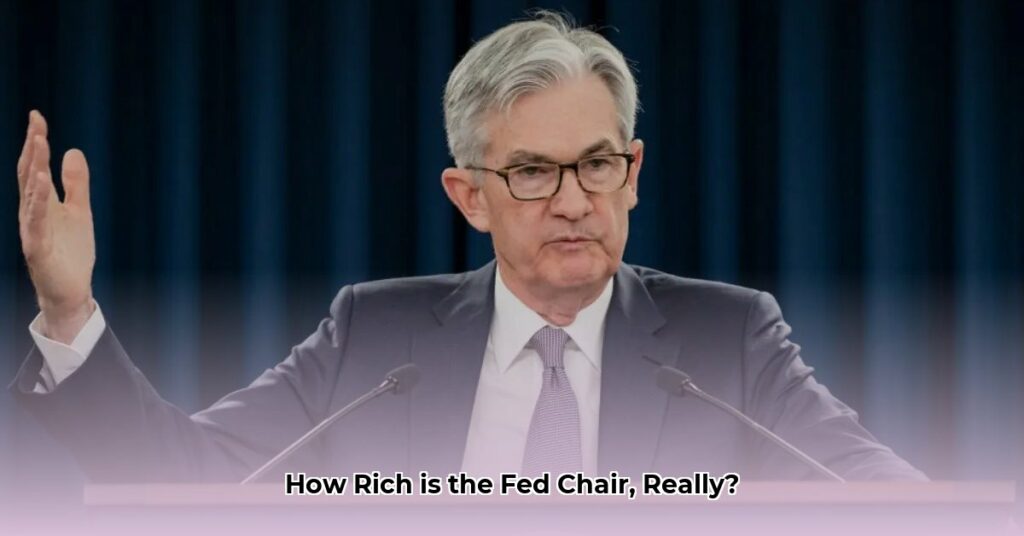Jerome Powell, the head of the Federal Reserve, holds significant influence over the U.S. economy. But his personal wealth, estimated to be between $20 million and $55 million, often raises questions. This article delves into Powell’s financial journey, exploring his career path, investments, and the potential implications of his wealth for his role as Fed Chair. His story offers a glimpse into the intersection of high finance, public service, and the complexities of wealth in positions of power.
Powell’s Path to Millions: From Law to Finance
Powell’s career began far from the world of monetary policy. After graduating from Georgetown Law in 1979, he honed his analytical skills at the prestigious law firm Davis Polk & Wardwell. This legal foundation, while seemingly unrelated to finance, likely provided him with a unique perspective that would prove valuable later.
His transition to investment banking at Dillon, Read & Co. in 1984 marked a pivotal moment. This move suggests a deliberate pursuit of wealth creation, applying his legal acumen to the lucrative world of finance. It was at Dillon, Read & Co. that Powell likely began to accumulate significant wealth, gaining experience in deal-making and market analysis.
The Carlyle Group: A Catalyst for Wealth
The most significant chapter in Powell’s financial story is undoubtedly his time at The Carlyle Group, a private equity powerhouse. From 1997 to 2005, Powell immersed himself in the world of leveraged buyouts, portfolio management, and high-stakes investments, primarily focusing on the industrial and transportation sectors. While the exact details of his compensation and investment performance remain largely private, his partnership at Carlyle almost certainly contributed substantially to his wealth. Private equity, known for its potential for high returns (and high risks), likely provided the largest boost to Powell’s fortune. His experience at Carlyle also gave him an intimate understanding of the inner workings of American industry, which may inform his perspective as Fed Chair.
Following Carlyle, Powell founded Severn Capital Partners and later led the Global Environment Fund. While less prominent than Carlyle, these ventures likely further diversified his portfolio and added to his overall net worth. His real estate holdings, including a multi-million dollar home in Chevy Chase, Maryland, and a vacation home in Vermont, further illustrate his financial success.
Public Service and Private Wealth: A Balancing Act
Powell’s transition to public service, first as a Federal Reserve Governor in 2012 and then as Chair in 2018, introduced a new dynamic to his financial narrative. While these roles offer respectable salaries (currently estimated around $203,500 for the Chair), they pale in comparison to the earning potential of private equity. This difference underscores the significant disparity in compensation between public and private sectors.
| Career Stage | Firm/Role | Approximate Dates | Likely Impact on Net Worth |
|---|---|---|---|
| Legal Career | Davis Polk & Wardwell | 1979-1984 | Foundation for Financial Skills |
| Investment Banking | Dillon, Read & Co. | 1984- onward | Significant Growth |
| Private Equity | The Carlyle Group | 1997-2005 | Substantial Increase |
| Private Investment | Severn Capital Partners, Global Environment Fund | 2005-2012 | Continued Growth |
| Federal Reserve Governor | Federal Reserve Board of Governors | 2012-2018 | Relatively Stable |
| Federal Reserve Chair | Federal Reserve Board of Governors | 2018-Present | Relatively Stable |
This table summarizes Powell’s career trajectory and its likely impact on his wealth. It’s important to note that this is a simplified overview, and the actual financial impact of each stage may be more complex.
Wealth, Power, and Public Perception
Powell’s substantial wealth inevitably raises questions about its potential influence on his policy decisions. Does his background in private equity, where maximizing returns is paramount, color his approach to monetary policy? Does it provide him with valuable insights, or does it create potential biases? These questions are central to ongoing discussions about the intersection of wealth, power, and public service. Further research is needed to fully understand the complexities of this relationship. Moreover, Powell’s experience may influence his response to financial system regulatory changes, potentially affecting future investment strategies.
Comparing Powell’s Wealth to Past Fed Chairs
While comprehensive data on the net worth of all previous Fed Chairs is difficult to obtain, available information suggests that Powell’s wealth may be higher than some of his predecessors. However, comparisons across different eras are complicated by factors like inflation and changing economic landscapes. Further research is necessary for a more accurate and nuanced comparison.
| Fed Chair | Estimated Net Worth (Approximate) |
|---|---|
| Jerome Powell | $20 million – $55 million |
| Janet Yellen | $8 million – $20 Million |
| Ben Bernanke | $2 Million – $5 Million |
| Alan Greenspan | $10 Million – $20 Million |
(These figures are estimates and may not reflect the most up-to-date valuations. Further research is needed for a more complete comparison.)
Transparency and the Future of Finance
Understanding Jerome Powell’s financial journey is crucial for evaluating his role as Fed Chair. His story underscores the importance of transparency in public service, particularly when personal wealth intersects with positions of significant power. Ongoing discussion and research are essential for navigating the complex relationship between private wealth, public service, and the future of finance. While estimates place Powell’s net worth in the tens of millions, the lack of precise figures underscores the need for greater financial disclosure from public officials. This transparency would promote public trust and allow for more informed discussions about potential conflicts of interest. Additionally, exploring the investment strategies Powell employed during his private equity years could provide further insight into his approach to financial decision-making – including whether he actively sought out investments aligned with socioeconomic impact or more traditional profit-driven strategies, offering insight into how he applies this approach to monetary policy decision processes within the Federal Reserve framework.



